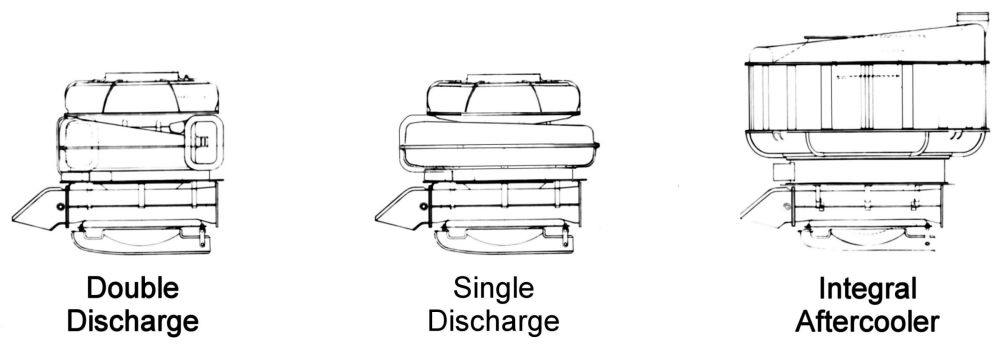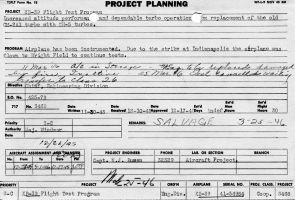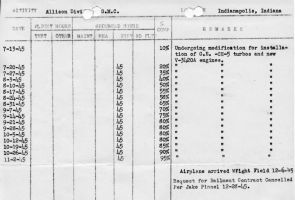t.jpg)
General Electric Type B-2 Turbosupercharger
Turbosuperchargers for Experimental USAAC Aircraft
circa 1942
Compiled by Kimble D. McCutcheon
Published 12 Nov 2023; Revised 4 Dec 2023
| Manufacturer / Model | Engine | Purchased Supercharger | Latest Supercharger Requirements | Air Force PO No. |
Contract / PO | Est Initial Flt Date | Revised Acft Delivery Date |
|---|---|---|---|---|---|---|---|
| Lockheed XP-49 | Continental XI-1430-1, XI-1430-7 | B-10 | B-10 | 190713 | 42-5643 | 1 May 1942 | 1 Aug 1942 |
| Vought XP-54 No. 1 | Lycoming XH-2470-1 | Type B | Type B | 1 Aug 1942 | 1 Oct 1942 | ||
| Vought XP-54 No. 2 | Lycoming XH-2470-1 | Type CM | Type CM | 219761 | AC-26996 | 1 Nov 1942 | 1 Jan 1943 |
| Lockheed XP-58 | Wright R-2160-3, R-2160-5 | E-2 | E-2 | 190910 | 42-5684 | 60 Days after Tornado Engine Receipt | |
| Curtiss-Wright XP-60A | Allison V-1710-75 | B-14 | B-14 | 224844 | AC-26997 | 1 Aug 1942 | 1 Nov 1942 |
| Curtiss-Wright XP-62 | Wright R-3350-17 | E-21 | Type CM | 219761 | AC-26997 | Sep 1942 Dec 1942 | Feb 1943 Mar 1943 |
| McDonnel XP-67 | Continental XIV-1430-1 | D-2 | D-2 | Field Service Section | Apr 1943 Oct 1943 | Aug 1943 1 Sep 1945 | |
| Republic XP-69 | Wright R-2160 | Type CM2 | Type CM | 219761 | AC-26997 | May 1943 Aug 1943 | 1 Aug 1943 Sep 1943 |
| Curtiss-Wright XP-71 | Pratt & Whitney X-Wasp (R-4360) | Type EM3 | Type E | 190822 | AC-26997 | May 1943 Aug 1943 | Aug 1943 Sep 1943 |
| Republic XP-72 | Pratt & Whitney X-Wasp (R-4360) | Type EM | Type EM | 219727 219744 | AC-26997 | ||
| North American XB-28, XB-28A | Pratt & Whitney R-2800-1, R-2800-15 | Type C | Type D | 164132 | AC-14192 | 13 Apr 1942 Jun 1942 | Jun 1942 Aug 1942 |
| Boeing XB-29 | Wright R-3350-13 | B-11 | B-11 | Prod Eng 192000 |
See AC-21619 | Aug 1942 | Nov 1942 |
| Consolidated XB-32 | Wright R-3350-13 | B-11 | B-11 | Jan 1943 Jul 1943 | Jan 1943 Jul 1943 | ||
| Martin XB-33 (1st two airplanes) | Wright R-2600-15 | Type C-24 | Type CMC | Jan 1943 Jul 1943 | Jan 1943 Jul 1943 | ||
| Northrop XB-35 | Pratt & Whitney X-Wasp (R-4360) | Type EM | Type EM | 219727 219744 | AC-26977 | 22 Aug 1943 22 Jan 1944 | 22 Nov 1943 4 Apr 1944 |
| Consolidated XB-36 | Pratt & Whitney X-Wasp (R-4360) | Type EM | Type EM | 219727 219744 | AC-26997 | 15 Feb 1944 15 Aug 1944 | 15 May 1944 15 Nov 1944 |
| Boeing XB-39 Nacelle Test | Allison V-3420 | Type C5 | Type C | Req's at Fisher Body Div, Jul 1942 | |||
Notes:
1. Four (4) each Type E-2 superchargers were originally procured for the XP-62 airplanes on Purchase Order 42-5683 resulting from Authority for Purchase (AFP) No. 190922, dated 10 Sep 1942. Lt. Colonel P.H. Robey, Major J.H, Sams, Mr. A.L. Berger, and Mr. McLane all stated that the General Electric Company (vendor) was not interested in building this type supercharger, and the above company, with the approval of the above mentioned Power Plant Laboratory Personnel approached the Curtiss Airplane Company with the intention of substituting the Type CM in lieu of the Type E-2. The Curtiss Airplane Company concurred, and, accordingly, twelve (12) each Type CM superchargers were procured by Mr. A.L. Berger.
2. Three was procured on Contract AC-26997, resulting from AFP No. 219761, dated 6 Mar 1942, twelve (12) each Type CM superchargers. The allocation was for two (2) each to Curtiss XP-62 airplanes, and ten (10) each to M.A.D. as spares. The requirement for the second XP-54 airplane was the Type CM supercharger, which was taken from the above mentioned procurement. The requirement for the XP-69 airplanes were Type CM superchargers and these also can be utilized from the original CM procurement mentioned above.
3. The supercharger originally outlined for use with the R-4360 (X-Wasp) engine was the Type EM. Accordingly, eight (8) each were set up for installation and spares in the two (2) XP-71 airplanes. It was later learned, however, that the Tyne E-2 would be the proper type, This left eight (8) ench Type EM superchargers as spares or to be utilized for other projects as they may have materialized. Regarding the Type E superchargers for the XP-71 airplane, the four (4) each Type E-2 superchargers for the XP-62 airplanes could be utilized for the XP-71 airplanes, although General Electric was informed of this change. so as to make the Type E-2 adaptable for XP-71 airplanes. It was assumed that modifications would be necessary. Such engineering as required between the airplane project officer, Power Plant Laboratory Supercharger Engineers, the General Electric Company, and the Curtiss Airplane Company would be made, providing the General Electric Company was agreeable to project continuation. Major J.H. Sams has stated that all engineering relative to the conversion of the E-2 supercharger originally procured for the XP-62 airplane, could be handled by his office when the occasion arises. Spares will have to be procured.
4. The original supercharger requirements for the XB-33 airplanes were Type C-2. A quantity of twelve (12) each Type C-2 superchargers were procured on Purchase Order 42-4556, resulting fr0m AFP No. 190826, dated 3 Jul 1941. Eight (8) each were for installation and four (4) each were for spares. With the cancellation of the XB-33 contract and the two (2) experimental airplanes being absorbed into the Production B-33 contract, the supercharger requirements were changed to Type CMC. The first two airplanes off the production contract for the Experimental Engineering Section had CMC superchargers furnished out of the Production Engineering Section's procurement and spares were to be made available from Field Service Section's quota. This arrangement for the actual installation articles was worked out with Mr. Markel of Production Engineering Section, who has initiated an AFP for eight (8) additional CMC superchargers, while the spares deal was arranged by Maj Sams with Lawrence J. Kuna of the Field Service Section. The Type C-2 supercharger, originally procured for the XB-33 airplanes were converted to the Type C-1 by Power Plant Laboratory personnel, and the C-1 superchargers were then assigned to Field Service Section to be utilized as spares for the Republic P-47B airplanes.
5. The supercharger required for use with the Allison XV-3420 engine in the XB-29 nacelle test to be conducted at the Fisher Body Division, General Motors Corporation, cannot be determined at this time. Lt Col D.L. Putt stated that he would contact Mr. Don Berlin of the Allison Engineering Company for the necessary information. If the C-1 was the proper supercharger type, Field Service Section could furnish this item. If it was found that the type was other than C-1, action to make available the proper type would be started when the type was determined.
t.jpg) |
t.jpg) |
 |
Feedback
 |
| D-23 Type Designation Sheet (Richardson) |
Steve Richardson noted that the McDonnel XP-67 was ultimately fitted with D-23 units. The Army's Final Report confirms this: "General Electric type D-23 turbo superchargers are installed giving engine ratings of 1,600 hp at 25,000 ft military and 2,100 hp war emergency." For a long time I thought this must be a typo, since I couldn't find any information on a GE D-23 turbo. Elsewhere in that Final Report, when describing how the program was initially scoped, it says "Power was supplied by two Continental XI-1430-1 engines equipped with General Electric Type D-2 turbo superchargers" and that the mockup review recommendations "included a request for provisions for the type BM turbo supercharger as an alternate for the type D-2" so the case for "D-23" being a typo seemed pretty strong. There was a 2 May 1942 report from Materiel Command on "Turbo Superchargers" that we've not found, that might shed some light on all this. In any case, back to the Final Report, the detailed description of the propulsion system does very clearly say D-23 turbos, "blower ratio 5.928:1 (engine stage)" so that sounds pretty definite.
Eventually, a single reference did turn up to confirm that such a thing existed. It shows "service test" being 3 Mar 1944, which would have been in the time between XP-67's 4th and 5th flights, when the aircraft was being extensively modified to incorporate stability and cooling changes suggested by wind tunnel testing. So I can't tell exactly when D-23s were installed but they do seem to have been in XP-67 for the great majority of its test flying. I also noticed that D-2 is listed on the Type Designation Sheets as being declared obsolete 12 Jan 1944, during the period of XP-67's first 4 flights. On the 4th flight the engines were accidentally oversped and had to be replaced, so I assume that's when the switch to D-23s was made.
Dan Whitney send copies of the original Boeing/Fisher XB-39 data pages (U.S. National Archives Record Group 342, RD1330, XB-39 pp3-4), which are from 1945/6, relating that the airplane originally had GE Type CM-2A1 turbos, which had then been replaced by CH-5s. The "CM" models had two-stages of supercharging and a single turbine. The "CH" models were single-stage utilizing improved metallurgy and a Whittle-derivative impeller, which allowed higher rpm and performance than the earlier "B" and "C" types.
 |
 |
| Boeing/Fisher Body Aircraft Development Section XB-39 Data Pages (NARA) | |